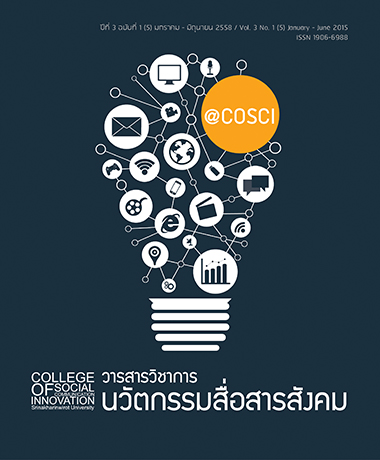คุณค่าข่าวในวิกฤตการณ์ทางสุขอนามัย
คำสำคัญ:
คุณค่าข่าว, การสื่อข่าว, วิกฤตการณ์ทางสุขอนามัย, News Values, Newsworthiness, News Reporting, Health Crisisบทคัดย่อ
การวิจัยนี้มีวัตถุประสงค์เพื่อศึกษาองค์ประกอบของหลักคุณค่าข่าวในภาวะวิกฤตทางสุขอนามัยและอันดับความสมควรเป็นข่าวขององค์ประกอบดังกล่าว กรณีศึกษาคือ วิกฤตการณ์ไข้หวัดนก โดยใช้วิธีวิจัยเชิงคุณภาพร่วมกับเชิงปริมาณ ได้แก่ การสัมภาษณ์เจาะลึกเพื่อรวบรวมคุณลักษณะของข้อมูลและเรื่องราวที่สมควรเป็นข่าวในวิกฤตการณ์ที่เป็นกรณีศึกษาจากผู้ให้ข้อมูลหลักที่มีความเกี่ยวข้องหรือบทบาทต่อวิกฤตการณ์จํานวน 44 คน หลังจากนั้นใช้วิธีการสํารวจด้วยแบบสอบถามเกี่ยวกับองค์ประกอบของหลักคุณค่าข่าวในภาวะวิกฤตที่ได้จากการสัมภาษณ์เชิงลึก จํานวนกลุ่มตัวอย่าง 508 คน หลังจากการเก็บรวบรวมข้อมูลแล้วจะวิเคราะห์ด้วยสถิติเชิงพรรณนาและสถิติเชิงอ้างอิง ได้แก่ การวิเคราะห์องค์ประกอบเชิงสํารวจ (Exploratory Factor Analysis) และการวิเคราะห์ความแปรปรวนแบบทางเดียว (One-way Analysis of Variance) ผลการศึกษาพบว่า องค์ประกอบของข้อมูลที่มีคุณค่าควรเป็นข่าวในวิกฤตการณ์ไข้หวัดนก องค์ประกอบของข้อมูลที่มีคุณค่าควรเป็นข่าวมี 9 องค์ประกอบเรียงลําดับจากมากไปน้อย ได้แก่ (1) องค์ความรู้เกี่ยวกับโรค (2) ความเสี่ยง (3) การแก้ไขปัญหาของภาครัฐ (4) ปรากฏการณ์รายวัน (5) ภูมิปัญญาชาวบ้าน (6) การเยียวยา (7) ผลกระทบ (8) ภูมิหลังของโรคระบาด และ (9) ความขัดแย้ง ส่วนองค์ประกอบด้านคุณลักษณะการนําเสนอที่มีคุณค่าควรเป็นข่าวมีทั้งหมด 5 ด้านได้แก่ (1) ความรวดเร็วในการนําเสนอ มี 2 องค์ประกอบ (2) ระดับการให้รายละเอียดของข้อมูล มี 2 องค์ประกอบ (3) ระดับการมีหลักฐานอ้างอิง มี 1 องค์ประกอบ (4) ความเหมาะสมเป็นแหล่งข้อมูล มี 4 องค์ประกอบ และ (5) แหล่งที่มาของข้อมูลแต่ละประเภท มี 3 องค์ประกอบ
News Values During Health Crisis
The research aims at studying what people think should be considered as news values or news elements during health crises and the newsworthiness of each element using the reporting of the bird flu crisis as cases. The research uses both qualitative and quantitative methods. First, the researcher interviewed various groups of people to compile what these groups viewed as the characteristics of the information and the stories that were worth reporting. The respondents include experts on crises, government personnel, the press and general public, 44 expressed their opinion on the coverage of on the bird flu crisis. Next, the researcher conducted a survey, asking 508 respondents from the above four groups to react with the news elements compiled from the depth-interview. The data were analyzed using descriptive and inferential statistics including the exploratory factor analyses and One-way ANOVA. For the bird flu crisis, the 9 news elements that the respondents considered worth reporting are (1) knowledge of the disease (2) risk (3) problem solving by the government (4) daily events (5) local wisdom (6) remedy (7) impacts (8) the background of the disease and (9) conflicts. Regarding the information characteristics the analysis yielded two factors related to timeliness, 2 factor related exhaustiveness, 1 factor related to supporting evidence, four factors related to the appropriateness of the sources and three factors related to the origin of the sources.
ดาวน์โหลด
รูปแบบการอ้างอิง
ฉบับ
ประเภทบทความ
สัญญาอนุญาต
บทความทุกบทความที่ได้รับการตีพิมพ์ถือเป็นลิขสิทธิ์ของวารสารวิชาการนวัตกรรมสื่อสารสังคม มหาวิทยาลัยศรีนครินทรวิโรฒ







